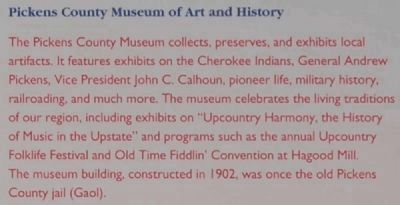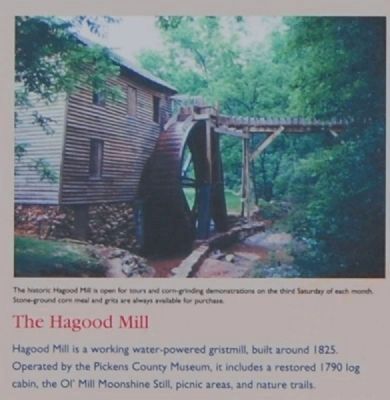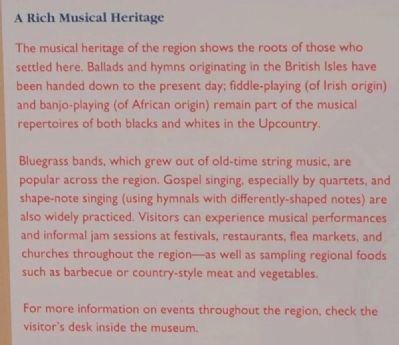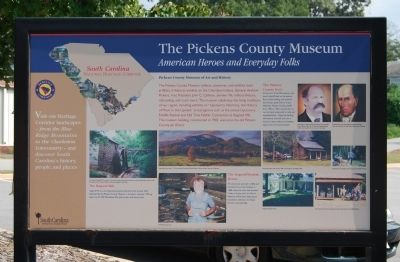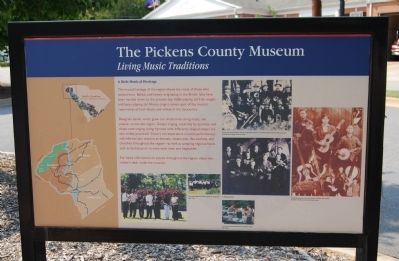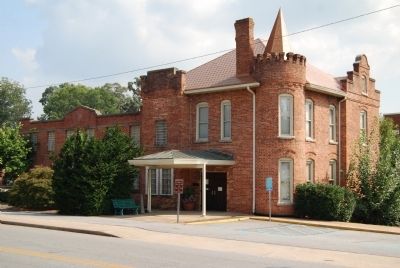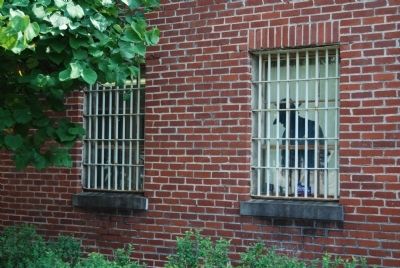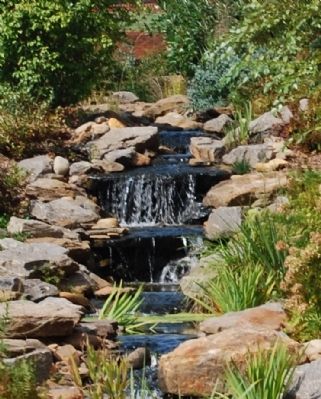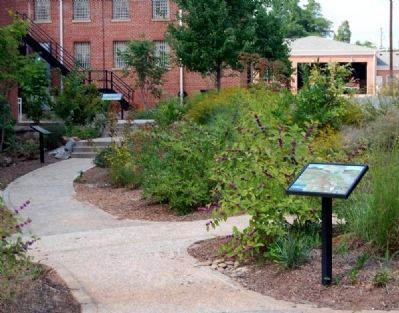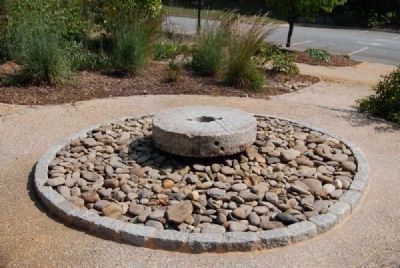Pickens in Pickens County, South Carolina — The American South (South Atlantic)
The Pickens County Museum
American Heroes and Everyday Folk
— Living Music Traditions —
Inscription.
Pickens County Museum of Art and History
The Pickens County Museum collects, preserves, and exhibits local artifacts. It features exhibits on the Cherokee Indians, General Andrew Pickens, Vice President John C. Calhoun, pioneer life, military history, railroading, and much more. The museum celebrates the living traditions of our region, including exhibits on "Upcountry Harmony, the History of Music in the Upstate" and programs such as the annual Upcountry Folklife Festival and Old Time Fiddlin' Convention at Hagood Mill. The museum building, constructed in 1902, was once the old Pickens County jail (Gaol).
The Pickens County Gaol
At the turn of the 20th century, the town's sheriff lived on the second floor of the building and cared for the inmates. James Henry Grace McDaniel, Pickens County Sheriff from 1892 to 1904, was the first to run the gaol, along with his wife and extended family. Today the building still features a jail cell, but now is home to many artifacts and exhibits about town and county history.
The Hagood Mill
Hagood Mill is a working water-powered gristmill, built around 1825. Operated by the Pickens County Museum, it includes a restored 1790 cabin, the Ol'Mill Moonshine Still, picnic areas, and nature trails.
The Hagood-Mauldin House
This structure was built in 1856 and moved to its current location in 1868, when the town was founded. Today it houses the Irma Morris Museum of Fine arts, featuring an impressive collection of antique furniture and paintings.
A Rich Musical Heritage
The musical heritage of the region shows the roots of those who settled here. Ballads and hymns originating in the British Idles have been handed down to the present day; fiddle-playing (of Irish origin) and banjo-playing (of African origin) remain part of the musical repertoires of both blacks and whites in the Upcountry.
Bluegrass bands, which grew out of old-time string music, are popular across the region. Gospel singing, especially by quartets, and shape-note singing (using hymnals with differently shaped notes) are also widely practiced. Visitors can experience musical performances and informal jam sessions at festivals, restaurants, flea markets, and churches throughout the region -- as well as sampling regional foods such as barbecue or country style meat and vegetables.
For more information on events throughout the region, check the visitors desk inside the museum.
Erected by South Carolina Heritage Corridor.
Topics and series. This historical marker is listed in these topic lists: Landmarks
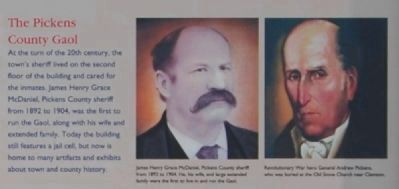
Photographed By Brian Scott, September 23, 2008
2. The Pickens County Museum Marker -
The Pickens County Gaol
The Pickens County Gaol
Left Caption: James Henry Grace McDaniel, Pickens County sheriff from 1892 to 1904. He, his wife, and large extended family were the first to live in and run the Gaol.
Right Caption: Revolutionary War General Andrew Pickens, who was buried at the Old Stone Church near Clemson.
Right Caption: Revolutionary War General Andrew Pickens, who was buried at the Old Stone Church near Clemson.
Location. 34° 52.867′ N, 82° 42.317′ W. Marker is in Pickens, South Carolina, in Pickens County. Marker is on Johnson Street. Marker is located in the parking lot in the rear of the museum. Touch for map. Marker is at or near this postal address: 307 Johnson Street, Pickens SC 29671, United States of America. Touch for directions.
Other nearby markers. At least 10 other markers are within walking distance of this marker. Blackford's Beauty (within shouting distance of this marker); Old Pickens Gaol (within shouting distance of this marker); Manly Portable Convict Cage (about 300 feet away, measured in a direct line); General Andrew Pickens Charted the Way (about 700 feet away); Pickens County Buffalo Soldiers (about 700 feet away); Pickens County Congressional Medal of Honor Memorial (about 700 feet away); To the Valiant Citizen-Soldiers of Pickens County (about 700 feet away); Major General Andrew Pickens (approx. 0.2 miles away); Andrew Pickens (approx. 0.2 miles away); Thomas Joab Mauldin (approx. 0.2 miles away). Touch for a list and map of all markers in Pickens.
Regarding The Pickens County Museum. The Pickens County Cultural Committee monitors operation of Pickens County Museum of Art and History and the Hagood Mill historic site as public, nonprofit educational institutions whose purpose is to collect, preserve, exhibit and interpret the artifacts, antiquities and archival, cultural and natural history of the County and surrounding geographic region.
Also see . . .
1. The Pickens County Museum - About Us. Pickens County Website (Submitted on March 13, 2021, by Larry Gertner of New York, New York.)
2. Old Pickens Jail. South Carolina Department of Archives and History entry:
The Old Pickens Jail is significant as one of the few early jails still in existence in Piedmont South Carolina. (Submitted on August 4, 2009, by Brian Scott of Anderson, South Carolina.)
3. Andrew Pickens. Wikipedia biography:
Andrew Pickens (September 13, 1739 – August 11, 1817) was a militia leader in the American Revolution and a member of the United States House of Representatives from South Carolina. (Submitted on August 4, 2009, by Brian Scott of Anderson, South Carolina.)
4. John C. Calhoun. Wikipedia biography:
John Caldwell Calhoun (March 18, 1782 – March 31, 1850) was the 7th Vice President of the United States and a leading Southern politician from South Carolina during the first half of the 19th century. Calhoun was an advocate of slavery, states' rights, limited government, and nullification. (Submitted on August 4, 2009, by Brian Scott of Anderson, South Carolina.)
5. Welcome to Pickens County, SC. Official website of Pickens County, SC. (Submitted on August 4, 2009, by Brian Scott of Anderson, South Carolina.)
Additional commentary.
1. Old Pickens Jail
Located in the town of Pickens, South Carolina, the Old Pickens County Jail is a two-story brick structure built circa 1903. An important landmark in Pickens, the Jail was originally constructed to serve as both a jail and as a residence for the Sheriff of Pickens County. The living quarters for the Sheriff were located in the west side of the building and a small two story cell block was located on the east. In 1928 the east side of the building was expanded in order to provide additional space for the cell block.
The original core of the Pickens Jail is a two-story structure constructed of brick laid in the common bond pattern. It features a hip roof with two interior chimneys and 1/1 segmented arch windows with granite sills. At its northeast corner is a two-story tower constructed of brick laid in the Flemish bond. This tower features 1/1 segmented arch windows, a crinolated tower and conical roof. Projecting bays are located along the first story of the north and west facades; it was removed during the late 1920s. The 1928 the
east side of the building was expanded to increase space in the cell block itself. This expansion took the form of a two-story brick detention wing. This wing features a flat roof, granite stringcourse and parapet, and 6/6 windows. In 1978 the exterior of the building was sandblasted.
Interior
The interior of Pickens Jail was originally divided into the Sheriff’s living quarters on the west and detention facilities on the east. The interior of the jail was renovated in 1975 to accommodate the building’s new function as a historical museum. These renovations mainly consisted of removal of the iron cell bars and the rearrangement of doors and stairways to provide better access between the original building and the cell block. In the 1903 section, the original wood staircase in the central hallway was removed, and a two-story space was created in the front section by removal of part of the second story floor. This created a balcony effect on the second floor level.
A steel staircase providing access to the second floor of the 1920s detention wing was replaced with a contemporary wood staircase. A door was cut through a load-bearing brick wall on the second floor to provide access to the upstairs portion previously independently served by the central hallway staircase. Housed, in the rear (south) addition, the existing first floor kitchen and second floor restroom facilities were retained.
In the 1920s section, six cell blocks and one maximum security or juvenile cell on the first floor were removed to provide space for the historical museum. A second maximum security or juvenile cell was retained for display, and the heavy steel doors and bars leading to the old cell blocks remain. An opening was cut through a 12” concrete wall which divided the first floor lengthwise into two equal spaces. This provided increased access on the first floor level. On the second floor, six cell blocks and an interior steel partition wall were removed to provide space for the art gallery.
The historical museum, kitchen, small conference room, and the county historical society’s office are located on the ground floor. The second floor houses the art gallery and Arts Commission. Although changes were made to the building in order to house the art gallery and historical museum, the Pickens County Jail is a notable example of the adaptive use of a local landmark for a new and viable function.
Surroundings
The Jail is located in downtown Pickens some two blocks below the county courthouse.
Significance
An important local landmark in Pickens, South Carolina, the Pickens County Jail was constructed in 1903 to serve as a detention facility for county criminals and as the home for the Sheriff of Pickens County and his family. The Pickens Jail is significant as one of the few early jails still in existence in the Piedmont of South Carolina. Used as a detention facility until August 1975, the Pickens County Jail is currently used as a historical museum and art gallery.
In July 1902 the Commissioners of Pickens County purchased one acre of land in the town of Pickens to be used for the construction of a new jail to replace an earlier wooden structure. The new jail was completed by 1903 when Pickens County Sheriff James Henry Grace McDaniel and his family moved into the building. Since it was the customer at that time for the sheriff to feed and care for the prisoners, the jail contained both cell blocks and living quarters for the sheriff’s family. During the residence of the McDaniel family in 1903, three members of the family contracted typhoid fever and died in the upstairs bedroom of the jail. This event is considered to be an important element in the folklore of the jail’s history in Pickens County. James Henry Grace McDaniel resigned as Sheriff in 1904 and the succeeding sheriffs of Pickens County continued to live in the jail. By 1918 the average daily population was approximately seven, and the jail itself was rated by the State Board of Charities and Corrections as having average conditions. In 1928, in answer to increased needs, a two-story cell block was added to the east side of the original jail building. The Pickens Jail was used continuously as a jail facility until August 1975 when a new county law enforcement center was constructed. The old Jail was subsequently turned over to the Pickens County Museum Commission and Arts Commission. After more than a year of restoration and renovation work, the Pickens Jail was opened in the fall of 1976 as a historical museum and art gallery. Although certain changes were necessary for the adaptive use of the building, Pickens County Jail remains an important local landmark which has been preserved due to its visible new use as a museum and Art Gallery. (Source: National Register nomination form.)
— Submitted August 4, 2009, by Brian Scott of Anderson, South Carolina.
2. Mother still keeps an eye on children at museum
Anderson Independent-Mail
JENNIFER JONES
Anderson Independent-Mail Saturday, October 22, 2005
There's just something about Halloween that brings out the ghost hunter in people. As the weather cools and dead leaves start to blow across the grass, those with an iota of belief in the supernatural perk up their ears and listen intently to creepy folklore passed around these here parts.
A few people inquire about the Pickens County Museum
every Halloween, executive director Allen Coleman said.
He admitted they have "a nice, little story of a benevolent spirit" at the museum involving a mother named Sarah, who apparently believed she had unfinished business to tend to after her death.
The Pickens County Museum used to be the old county jail, constructed in 1903. Sarah's husband, James Henry Grace McDaniel, was the sheriff, and his older sons were deputies. You could say the jail was a sort of family-operated business, as the couple and their 13 children lived right there on site.
"In addition to cell blocks, they had a kitchen, a living room and an apartment upstairs. There was even a piano there to entertain, and Sarah did chores and cooking and cleaning," Mr. Coleman said.
Because she had so many small children to keep an eye on while inside cooking or cleaning "Sarah would stick her head out of the window from time to time to make sure they were playing nicely" Mr. Coleman said.
Tragedy struck when the sewer contaminated the well water and several members of the family contracted typhoid fever as a result. Sarah, her oldest daughter and her older son's wife all died in the upstairs apartment, which is now one of the museum Galleries.
"The story is that Sarah passed away brokenhearted and didn't want to leave her children," Mr. Coleman said. "It's been said
that if you're driving down Highway 178 at night and you look up at the upstairs window thereabouts by the old turret, you'll see her looking out to make sure than her children are OK. I've had one person say it happens during a full moon, another said it's only at midnight. Just like with any story passed around, everybody adds to it."
As for Mr. Coleman, however, he's never seen anything for himself. The only time things are moved is when they move them themselves, he said.
"I've never seen Sarah or heard Sarah," he said. "It's a story that's been passed down from previous people who had worked here and I've heard townspeople talk about it."
He admitted that he sometimes talks to Sarah when he's working on something to explain what he's doing and his reason for changing things.
"If she's here, she's a benevolent good gal so more power to her," he said. "She's a peace."
— Submitted August 4, 2009, by Brian Scott of Anderson, South Carolina.
Credits. This page was last revised on March 13, 2021. It was originally submitted on September 26, 2008, by Brian Scott of Anderson, South Carolina. This page has been viewed 1,587 times since then and 29 times this year. Photos: 1, 2, 3, 4, 5. submitted on August 4, 2009, by Brian Scott of Anderson, South Carolina. 6, 7, 8, 9, 10. submitted on September 26, 2008, by Brian Scott of Anderson, South Carolina. 11, 12. submitted on August 4, 2009, by Brian Scott of Anderson, South Carolina.
